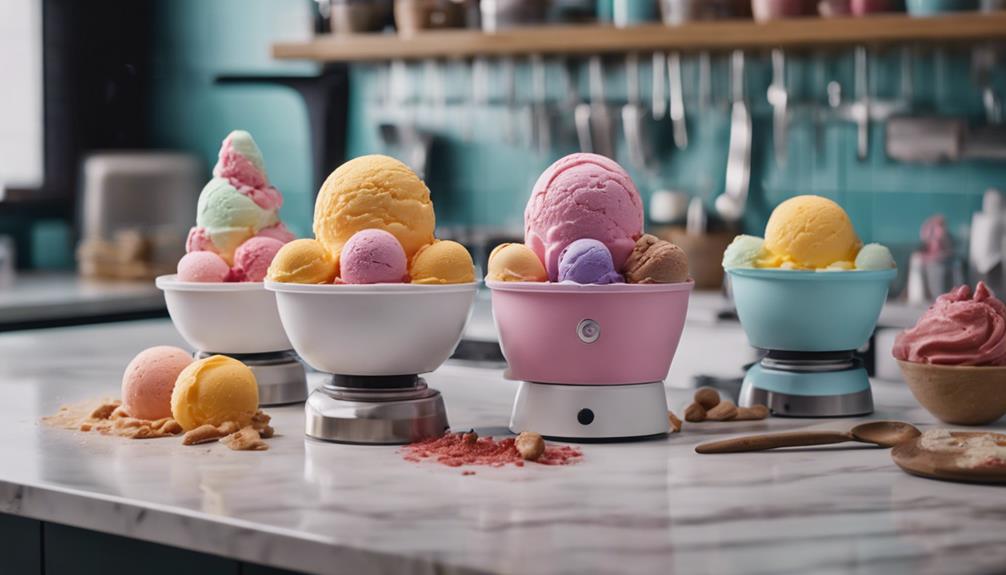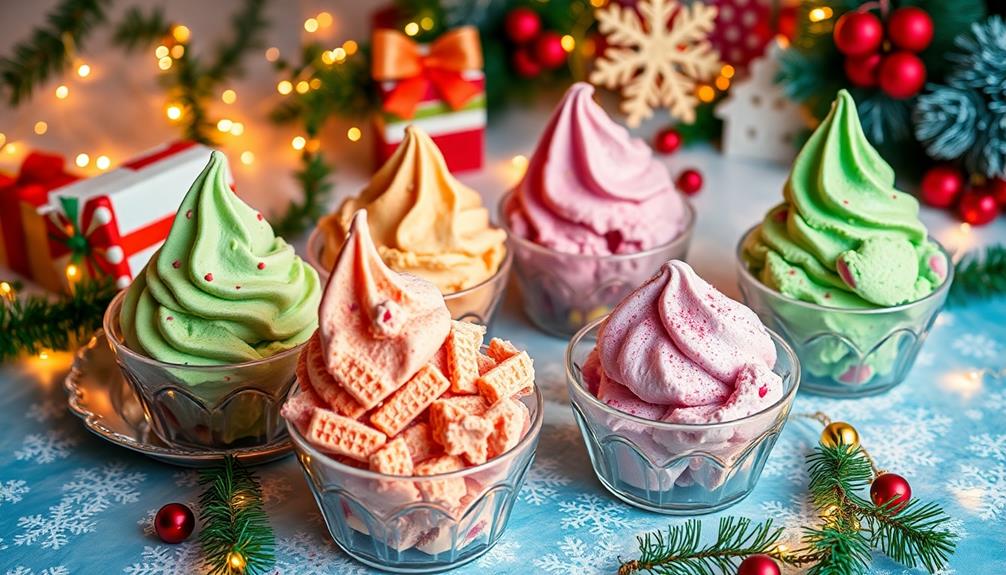If you are seeking a one-of-a-kind dessert experience, the ice cream oyster is a culinary treasure that combines savory and sweet flavors. This delicious treat merges the salty essence of oysters with the creamy sweetness of ice cream, resulting in a surprisingly delightful combination. The Ice Cream Oysters at Corner Cottage Bakery provide a premium take on classic desserts, highlighting coastal culinary innovation. Are you prepared to excite your taste buds with this fascinating dessert that honors local ingredients?
Key Takeaways
- Ice Cream Oyster is a unique dessert blending oysters and ice cream.
- It features a creamy base infused with briny oyster essence.
- Historical roots date back to early America with recipes by Mary Randolph and Dolley Madison.
- Oyster ice cream offers a blend of savory and sweet flavors, a culinary fusion.
- Coastal chefs use fresh, locally sourced ingredients to create this innovative treat.
Historical Roots of Oyster Ice Cream
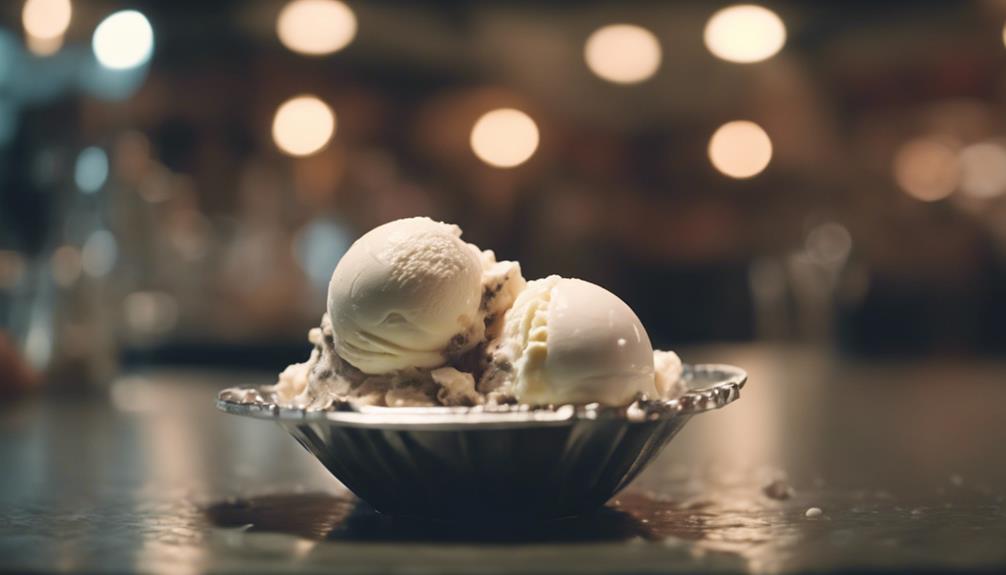
Historical roots of oyster ice cream trace back to early America, where it gained popularity among various social classes and culinary enthusiasts.
Mary Randolph and Dolley Madison, notable figures in early American culinary history, included recipes for this unique dessert in their American cookbooks.
The ice cream base for oyster ice cream often consisted of cream, sugar, and eggs, blended with the briny essence of oysters to create a savory-sweet flavor profile.
Colonial Williamsburg, known for its historical reenactments and preservation of early American culture, also showcased oyster ice cream as part of the diverse range of ice cream flavors available during that era.
This unusual dessert challenged traditional norms, offering a glimpse into the culinary experimentation and creativity of early American cuisine.
The popularity of oyster ice cream among different social classes highlighted its appeal and significance in the evolving gastronomic landscape of early America.
Culinary Fusion: Oysters and Ice Cream

When blending the savory essence of oysters with the creamy sweetness of ice cream, a unique culinary fusion emerges that challenges traditional dessert norms. This unexpected combination of flavors in oyster ice cream has a rich history dating back to the 19th century, showcasing the bold and innovative spirit of early American cuisine.
Culinary experts speculate that this intriguing dish may have been enjoyed as a sophisticated palate cleanser or even as a chilled soup, highlighting the versatility of oysters in dessert recipes.
Here are some fascinating insights into the fusion of oysters and ice cream:
- Oyster ice cream blends the savory flavors of oysters with the sweet creaminess of ice cream for a unique culinary experience.
- Historical recipes dating back to the early 19th century feature oysters as a key ingredient in ice cream, challenging traditional dessert norms.
- Combining oysters and ice cream showcases the creativity and innovation of early American cuisine, reflecting a time when exotic flavors were celebrated.
- Culinary experts are intrigued by the fusion of oysters and ice cream, suggesting that the dish may have been a sophisticated palate cleanser or chilled soup.
- Oyster ice cream represents a fascinating culinary experiment that invites further exploration into the unconventional dessert trends of early-American cuisine.
Unconventional Ice Cream Flavors
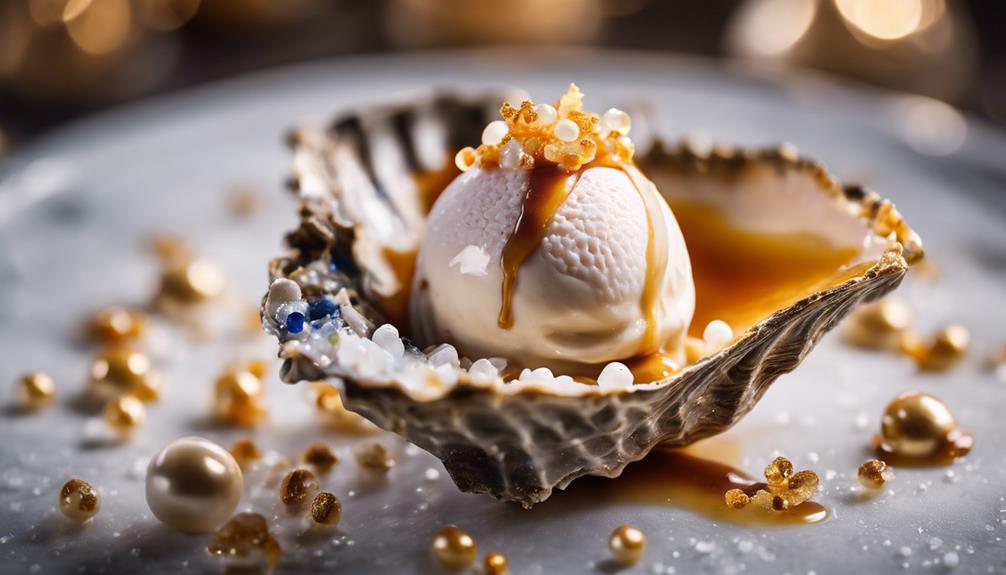
Exploring the world of unconventional ice cream flavors opens up a world of daring and innovative taste experiences that challenge traditional dessert boundaries. At Velvet Freeze, Karel Blaas from Wilmington crafts a range of unique flavors, including the intriguing oyster ice cream. This unconventional treat takes a historical nod from American food culture while offering a one-of-a-kind dessert experience.
| Flavor | Ingredients | Serving Combinations |
|---|---|---|
| Oyster Ice Cream | Poached oysters in cream with added sugar | Texas Pete swirl, fennel panna cotta, chocolate ganache cake |
| Bourbon Bacon Chocolate Pecan | Bourbon, bacon, chocolate, pecan | Served in a waffle cone with candied bacon sprinkles |
| Olive Oil with Toasted Pine Nuts | Olive oil, toasted pine nuts | Paired with a drizzle of balsamic reduction |
Blaas' inventive combinations like bourbon bacon chocolate pecan and olive oil with toasted pine nuts provide a deliciously unexpected twist to the world of desserts. The oyster ice cream, sweetened through the poaching process, showcases the creativity and innovation present in Velvet Freeze's lineup of unconventional flavors.
Making Oyster Ice Cream at Home
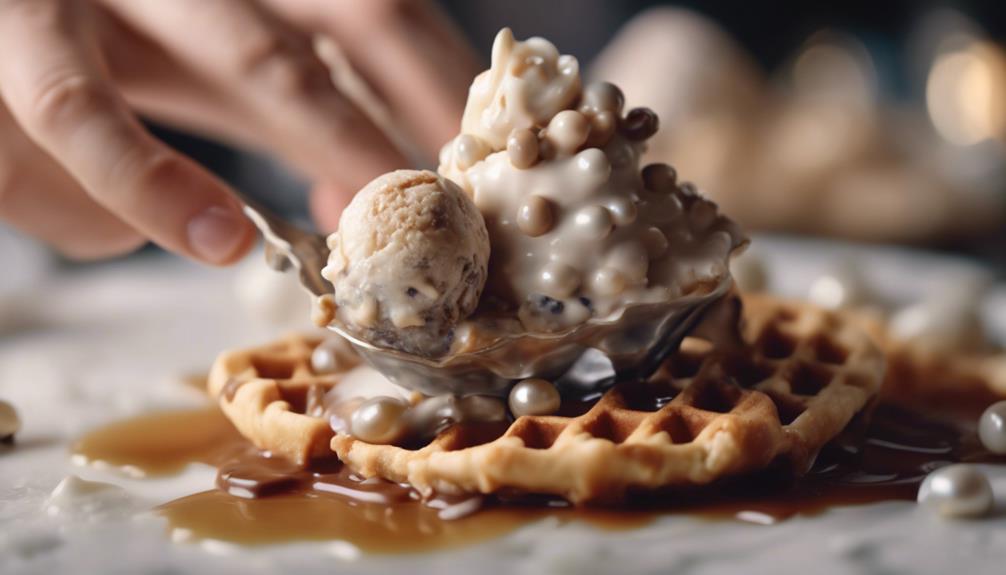
If you're keen on trying your hand at making oyster ice cream at home, understanding its origins can provide valuable insights.
Tips for crafting homemade ice cream with oyster flavors will help you achieve a delectable and unique treat.
Stay tuned for more on the historical roots and practical advice for creating this intriguing dessert.
Oyster Ice Cream Origins
To make oyster ice cream at home, start by poaching fresh shucked oysters in a vanilla ice cream base.
The origins of oyster ice cream trace back to early America, with a recipe found in Mary Randolph's 1824 cookbook, the 'Virginia Housewife'. This unique dessert was enjoyed by prominent figures like George Washington and Thomas Jefferson, who appreciated its savory-sweet combination.
Historical recipes offer variations such as oyster cream soup or a custard-like oyster ice cream, showcasing the versatility of this coastal delicacy.
Traditional methods of making oyster ice cream involve ingredients commonly found in an ice house, while modern techniques like sous-vide present innovative ways to enhance the flavors.
Coastal culinary traditions often celebrate local ingredients and flavors, making dishes like oyster ice cream a true representation of regional cuisine.
Homemade Ice Cream Tips
Consider incorporating fresh shucked oysters into a vanilla ice cream base when attempting to make oyster ice cream at home. This unique dessert blends the creamy sweetness of ice cream with the savory taste of oysters, creating a surprising and delightful flavor combination. To help you get started, here are some homemade ice cream tips for making oyster ice cream:
| Ingredient | Instructions | Tips |
|---|---|---|
| Fresh Oysters | Poach in vanilla ice cream base | Adjust oyster amount for flavor |
| Vanilla Ice Cream | Blend with poached oysters | Use high-quality vanilla ice cream |
| Slow Cooking | Consider sous-vide method | Enhances oyster flavor |
For a simpler approach, Mary Randolph's recipe involves creating a rich oyster soup, straining it, and freezing it to achieve a similar taste. Experiment with different methods to find the one that suits your taste buds the best. Enjoy the process of creating this unconventional yet delicious homemade ice cream treat!
Unique Desserts: Ice Cream Oysters

With their premium ice cream served in a shell-like presentation, Ice Cream Oysters offer a unique and visually appealing twist on traditional desserts. These delightful creations have become a sensation at Corner Cottage Bakery, where innovation meets indulgence.
Here's why you should consider trying these unique desserts:
- Artisanal Experience: Indulge in the premium ice cream section of Corner Cottage Bakery for a truly artisanal experience.
- Creative Presentation: The playful shell-like presentation adds a whimsical touch to your dessert.
- Quality Ingredients: Ice Cream Oysters are crafted using high-quality ingredients, ensuring a delicious treat.
- Novelty Factor: Stand out from the crowd by opting for these unconventional desserts that are sure to impress.
- Flavor Combinations: Explore a variety of delicious flavor combinations that make Ice Cream Oysters a must-try for dessert enthusiasts.
Coastal Cuisine: Oyster Ice Cream
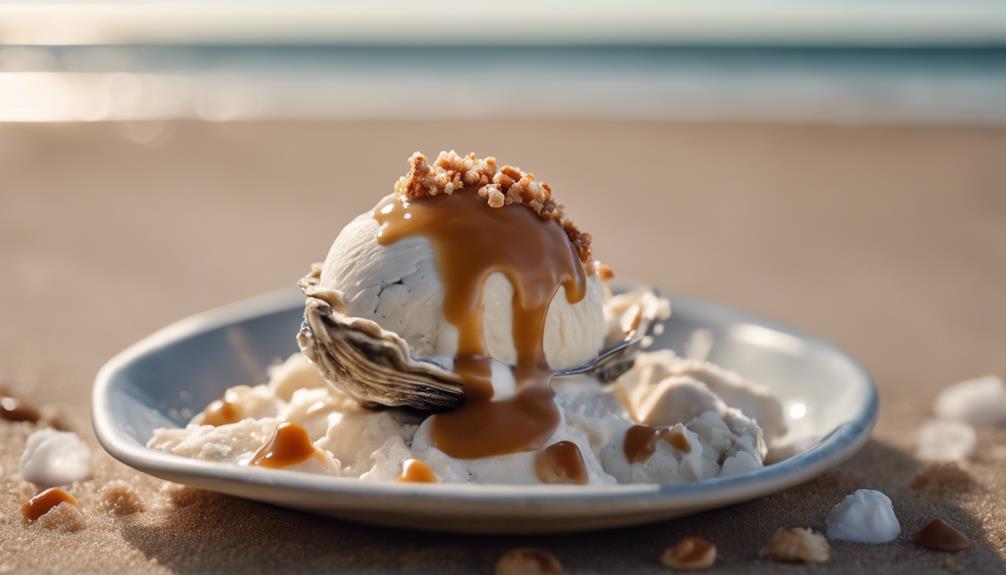
Discover the rich coastal culinary traditions that inspire the creation of oyster ice cream.
Explore the intriguing process of making this unique dessert that blends savory oysters with sweet ice cream.
Uncover the fascinating history behind oyster ice cream and its evolution as a delicacy rooted in coastal regions.
Coastal Culinary Traditions
Exploring coastal culinary traditions reveals a unique delicacy: oyster ice cream, a surprising yet delightful treat that showcases the region's creative and diverse cuisine. Coastal cuisine along the North Carolina coast often incorporates local ingredients and flavors, emphasizing the rich culinary heritage passed down through generations. Oyster ice cream stands out as one of the many unique dishes found in this region, highlighting the culinary diversity that defines coastal cuisine.
- Local Ingredients: Coastal chefs use fresh, regionally sourced ingredients to create dishes like oyster ice cream, connecting diners to the area's abundant seafood and produce.
- Culinary Heritage: Traditional recipes and cooking techniques play a significant role in shaping the flavors and textures of coastal dishes, preserving the culinary legacy of the area.
- Unique Dishes: Oyster ice cream exemplifies the innovative and unexpected creations that emerge from the vibrant culinary scene along the coast.
- North Carolina Coast: The coastal region of North Carolina serves as a hub for culinary exploration, drawing inspiration from the abundant waters and fertile lands that surround it.
- Traditional Recipes: Explore the history and stories behind classic coastal recipes, uncovering the origins of beloved dishes like oyster ice cream.
Making Oyster Ice Cream
To prepare oyster ice cream, start by selecting fresh oysters and gathering the necessary ingredients for this unique coastal dessert. Begin by making an oyster soup to infuse the flavor into the ice cream.
In a saucepan, cook the oysters until the edges curl, then strain and reserve the liquid. Add butter, flour, and the reserved liquid to make a thick soup. Season with thyme for a savory touch. Next, whisk beaten eggs into the soup to thicken it further.
Once the soup is ready, let it cool before transferring it to an ice cream machine. Churn the mixture until it reaches a creamy consistency. The result is a delightful blend of sweet and savory flavors that will surprise your taste buds.
Experiment with the intensity of the oyster taste to find the perfect balance for your palate. Enjoy this unique dessert that combines the richness of oysters with the creaminess of ice cream.
Oyster Ice Cream History
Oyster ice cream's historical significance in early American cuisine can be traced back to Mary Randolph's 1824 cookbook, where a recipe for this unique dessert was featured. Dolley Madison, the esteemed White House hostess, was rumored to favor oyster ice cream at her lavish gatherings, showcasing its popularity during her time.
Alongside flavors like apricot and pink peppermint, oyster ice cream stood out as a unique and savory dessert choice. The process of making this intriguing treat involves poaching fresh shucked oysters in a vanilla ice cream base, creating a distinctive flavor profile.
Oyster ice cream not only reflects early American culinary traditions but also offers a glimpse into the innovative combinations of seafood and sweet frozen delights from that era.
Oyster Ice Cream Recipes

Consider incorporating fresh shucked oysters poached in a vanilla ice cream base when preparing oyster ice cream recipes. These recipes offer a unique twist by combining savory elements with sweet flavors.
Chefs experiment with historical recipes that include ingredients like onions, ham, pepper, salt, and eggs, providing a rich and complex taste experience. To infuse the oyster flavor effectively, some use slow cooking techniques such as sous-vide, ensuring a well-balanced incorporation of the seafood essence into the dessert.
Additionally, oyster ice cream recipes showcase a blend of unique flavor combinations like fennel panna cotta and chocolate ganache cake, adding a touch of creativity to this unconventional treat.
The versatility of oyster ice cream lies in its ability to merge sweet and savory elements seamlessly, creating a dessert that surprises and delights the palate. Try these innovative recipes to experience a one-of-a-kind culinary adventure.
Frequently Asked Questions
What Does Oyster Ice Cream Taste Like?
Oyster ice cream tastes like a fusion of creamy sweetness and subtle oceanic undertones. The unique flavor profile balances the dairy richness of ice cream with the briny essence of oysters, offering a surprising and memorable culinary experience.
How Is Oyster Ice Cream Made?
To make oyster ice cream, infuse oyster flavor into a creamy custard base with stock and cream. Add vanilla, sugar, or spices for extra flair. Churn the mix in an ice cream machine until frozen for a unique treat.
Which First Lady Liked Oyster Ice Cream?
Dolley Madison, a famous White House hostess, enjoyed oyster ice cream. She served a variety of flavors, including oyster, at events like inaugural balls. Her extravagant parties popularized ice cream desserts during her time.
What Is Ice Cream Dessert?
Ice cream dessert is a delightful treat enjoyed by many. It offers a cool and creamy indulgence that satisfies your sweet cravings. Whether in a cone or cup, ice cream is a classic dessert favorite.
Why Is Sliding Mitt Ice Cream a Unique and Innovative Dessert Option?
Sliding mitt ice cream offers a unique and innovative dessert experience. With its handheld design and convenient sliding mechanism, this dessert option is both fun and practical. It allows for easy enjoyment without the mess and hassle of traditional ice cream cones, making it a standout choice for dessert lovers.
Conclusion
So there you have it, folks! Oyster ice cream is a delightful twist on a classic treat that will surely surprise your taste buds.
Don't be afraid to get shell-shocked by this unique dessert. Whip up a batch at home and transport yourself back to a time when ice cream parlors were all the rage.
Who knows, maybe you'll discover a new favorite flavor that will have you shucking for more!

